There is no doubt that one of the most debatable aspects of the theory of evolution concerns the evolution of man. According to the NAS, ". . . today there is no significant scientific doubt about the close evolutionary relationships among all primates, including humans." (Science and Creationism, p. 23) In fact, however, fossil discoveries and other findings in recent years have shown that there is no scientific basis to the claim that human beings and apes are descended from a common ancestor. Even evolutionist scientists admit that the question of human evolution has become an intractable problem. The NAS's claims regarding so-called human evolution are supported by no scientific evidence whatsoever. Let us now set out these claims and the responses to them.
The NAS's self-confident style, evident throughout the book, although lacking any evidential basis whatsoever, is also apparent in the chapter dealing with so-called human evolution. However, even evolutionists admit that this claim fails to reflect the truth. As Professor Peter Andrews of the British Museum of Natural History admits in an article published in Nature, the lack of a hominid fossil record before about 5 million years ago is an important dilemma and source of disappointment for evolutionists.1
Richard C. Lewontin from Harvard University has sincerely admitted the problematic nature of evolutionary scenarios on human origins:
When we consider the remote past, before the origin of the actual species Homo sapiens, we are faced with a fragmentary and disconnected fossil record. Despite the excited and optimistic claims that have been made by some paleontologist, no fossil hominid species can be established as our direct ancestor.2

Contrary to the claims of the NAS, far from supporting evolutionary theories, recent discoveries regarding the origin of man actually undermine them. Fossil discoveries are tearing down the evolutionary trees that scientists have been attempting to construct for dozens of years, while biochemical comparisons show that the genetic differences between human beings and apes are much greater than had been supposed. Admissions of error in well-known scientific magazines and evolutionist publications are a of clear indication of this.
Henry Gee, senior editor of Nature, in an article published in July 12, 2001 admits that despite all the paleontological excavations, no evolutionary links between humans and chimpanzees, which are our supposed closest living relatives, have been established:
Moreover, it remains the case that although hominid fossils are famously rare, the chimpanzee lineage has no fossil record whatsoever.3
Henry Gee is not alone in making confessions of this kind. Professor Bernard Wood of George Washington University, for instance, says in an article in Nature that the taxonomic and phylogenetic relationships surrounding man's evolutionary origin are still shrouded in darkness, stating:
It is remarkable that the taxonomy and phylogenetic relationships of the earliest known representatives of our own genus, Homo, remain obscure. Advances in techniques for absolute dating and reassessments of the fossils themselves have rendered untenable a simple unilinear model of human evolution, in which Homo habilis succeeded the australopithecines and then evolved via H. erectus into H. sapiens—but no clear alternative consensus has yet emerged.4
In short, it has emerged that the classic evolutionary scheme from Australopithecus to modern man is incompatible with scientific findings, but no other model of evolution can be proposed. Thus, the theory of evolution is in "crisis," as Michael Denton puts it, with regard to the origin of man, as well. In its March 14, 1994, issue, Time magazine openly stated how the fossil record has left the theory of evolution in a severe quandary:
Yet despite more than a century of digging, the fossil record remains maddeningly sparse. With so few clues, even a single bone that doesn't fit into the picture can upset everything. Virtually every major discovery has put deep cracks in the conventional wisdom and forced scientists to concoct new theories, amid furious debate.5
As we have seen, even evolutionist scientists and publications admit that the fossil record fails to provide any evidence for the idea of human evolution. Nonetheless, the NAS booklet totally ignores these facts as it sets out its groundless claims.
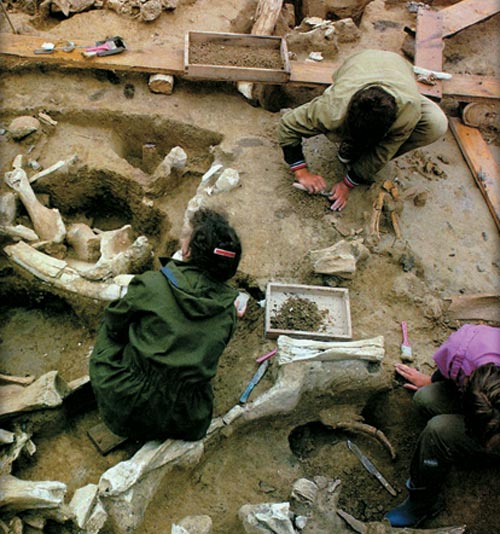
For around 150 years, evolutionist paleontologists have been looking for fossils to prove the theory of evolution. Yet, these searches have produced no results.
In its chapter on human evolution, the NAS devotes the greatest space to Australopithecus, suggesting that these creatures were transitional forms with half-human, half-ape features.
The fact is, however, that these creatures—to whom the suffix "–pithecus," the Latinized Greek equivalent of "tailless ape," is applied—are actually an extinct species of ape and represent no evidence at all of human evolution. In fact, Australopithecus closely resembles the chimpanzee. Lucy, for instance, the best-known example of Australopithecus (Australopithecus afarensis), had a chimp-sized brain, chimp-shaped rib cage and jawbone, and arms and legs that indicate it walked like a chimp. It even had a chimp shaped pelvis.6

To the right is the Australopithecus afarensis skull AL 444-2, and below a modern chimpanzee skull. The very clear similarity between them is an evident indication that A. afarensis was an ordinary species of ape with no human features.
The evolutionist claim on this subject, however, is that despite having a totally simian anatomy, Australopithecus walked upright, like human beings and unlike apes.
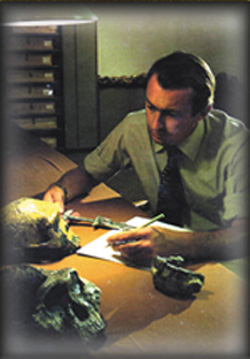
Richard Leakey
This "walking upright" claim is a view that has been maintained by evolutionist paleoanthropologists like Richard Leakey and Donald Johanson for many years. However, many scientists who have examined the Australopithecus skeletal structure have refuted this claim. Two world-famous British and American anatomists, Lord Solly Zuckerman and Professor Charles Oxnard, carried out wide-ranging examinations of Australopithecus specimens and showed that these creatures were not bipedal but moved in the same manner as modern apes. Despite being an evolutionist himself, Lord Zuckerman, who spent 15 years studying various Australopithecus specimens with a team of five experts backed by the British government, arrived at the conclusion that Australopithecus was an ordinary species of ape and very definitely did not walk upright.7
Charles E. Oxnard, another evolutionist well-known for his research in this area, also likened the skeletal structure of Australopithecus to that of present-day orangutans.8
 The point regarding bipedalism which evolutionists particularly stress is the angle at which the femur comes down and meets the knee, known as the "carrying angle." Human beings are able to carry their weight on their feet as they walk because their upper leg bones and lower leg bones meet at an approximate 9 degree angle at the knee joint. In the chimpanzees and gorillas, however, the thigh and shin bones form a straight line, with a carrying angle of essentially 0 degrees. These animals only manage to carry their weight on their feet when they walk by swinging their bodies from one direction to another in the "ape-walk." Evolutionists assume that ape fossils with a high carrying angle somewhat similar to the human condition walked on two legs and thus evolved into human beings. The reason that australopithecines are regarded as ancestors of man is that they generally have a carrying angle of about 15 degrees. However, many evolutionists now accept that this angle indicates that these creatures were expert tree climbers. In fact, the largest carrying angle among living primates is found in the orangutan and the spider monkey, both of which are excellent tree-climbers. In other words, the anatomical feature that evolutionists portray as evidence of bipedalism is possessed by arboreal monkeys, which no-one suggests were the ancestors of man.
The point regarding bipedalism which evolutionists particularly stress is the angle at which the femur comes down and meets the knee, known as the "carrying angle." Human beings are able to carry their weight on their feet as they walk because their upper leg bones and lower leg bones meet at an approximate 9 degree angle at the knee joint. In the chimpanzees and gorillas, however, the thigh and shin bones form a straight line, with a carrying angle of essentially 0 degrees. These animals only manage to carry their weight on their feet when they walk by swinging their bodies from one direction to another in the "ape-walk." Evolutionists assume that ape fossils with a high carrying angle somewhat similar to the human condition walked on two legs and thus evolved into human beings. The reason that australopithecines are regarded as ancestors of man is that they generally have a carrying angle of about 15 degrees. However, many evolutionists now accept that this angle indicates that these creatures were expert tree climbers. In fact, the largest carrying angle among living primates is found in the orangutan and the spider monkey, both of which are excellent tree-climbers. In other words, the anatomical feature that evolutionists portray as evidence of bipedalism is possessed by arboreal monkeys, which no-one suggests were the ancestors of man.
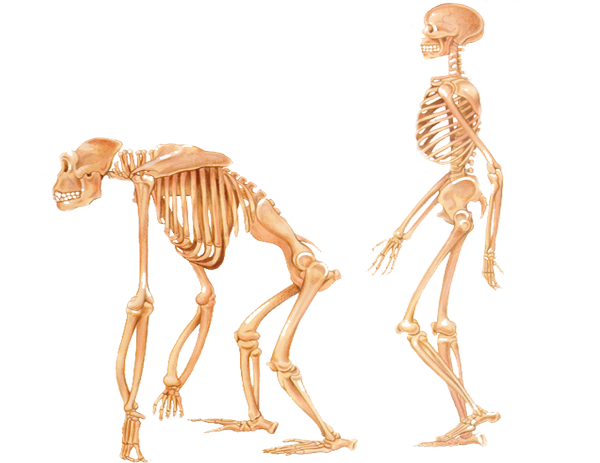
The postures of human beings and apes are very different. Humans have an erect body posture and walk upright, while apes lean their bodies forward and use their arms for support.
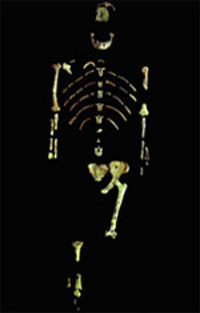
The latest research has shown that Lucy possessed the skeletal features of knuckle-walking apes.
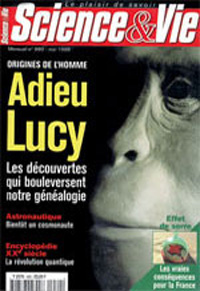
Scientific findings have proven the evolutionist assumptions regarding Lucy, the bestknown example of the genus Australopithecus, to be unfounded. In its February 1999 issue, the well-known French scientific magazine Science et Vie accepted this in an article entitled "Adieu Lucy," and confirmed that Australopithecus cannot be considered an ancestor of man.
In addition, Lucy's wrist joints show that this creature was a quadrupedal knuckle-walker, which is a distinguishing feature of modern apes. Brian G. Richmond and David S. Strait of George Washington University described four skeletal features of distal radius of knuckle-walking apes, chimpanzees, and gorillas. The two researchers investigated Lucy and other fossils claimed to be hominid, and stated that Lucy possessed the same skeletal structure as knuckle-walking apes.9
As we have seen, detailed studies of Australopithecus show that these creatures did not stand upright and walk on two legs, but on the contrary possessed a knee structure and gait seen in present-day chimpanzees and gorillas.
It needs to be made clear that even if Australopithecus were bipedal, this would still be insufficient to prove it was an ancestor of man. Bernard Wood says that bipedalism should not be regarded as a feature distinguishing man from apes, and cites the following example, "birds have wings, but not all creatures with wings are birds."10
The fact that Australopithecus cannot be considered an ancestor of man is also accepted by evolutionist sources. The well-known French magazine Science et Vie made this its cover story of its May 1999 issue. The story dealt with Lucy, the best-known fossil specimen of Australopithecus afarensis, under the title "Adieu Lucy," and wrote of the need to remove Australopithecus from the human family tree. The article, based on the discovery of a new Australopithecus, code number St W573, stated:
A new theory states that the genus Australopithecus is not the root of the human race… The results arrived at by the only woman authorized to examine St W573 are different from the normal theories regarding mankind's ancestors: this destroys the hominid family tree. Large primates, considered the ancestors of man, have been removed from the equation of this family tree… Australopithecus and Homo (human) species do not appear on the same branch. Man's direct ancestors are still waiting to be discovered.11

The NAS authors claim that data from molecular biology provides proof of the so-called evolution of man. This is yet another of the NAS's unrealistic claims. We have already seen that molecular biology does not provide evidence of evolution, and this chapter will touch in brief on the way that the data from molecular biology conflict with the claims of human evolution.

The NAS's claim with regard to molecular biology is based on the hypothesis that human beings are genetically closer to chimpanzees and gorillas than to orangutans and other primates. The fact is, however, that this is a totally incorrect analysis. First of all, it needs to be made clear that the human genome was deciphered in 1998, the year the NAS booklet was published. The results of the Human Genome Project were published in 2001. The genetic codes of the chimpanzee and gorilla have not yet been deciphered. Therefore, it is not yet possible to make a reliable comparison between these species. Claims of this kind that appear in certain publications are based on comparisons of a limited number of proteins or genes. For this reason, when a comparison is carried out on another protein or molecule, it may give rise to very different or even conflicting results.

The Swedish paleontologist Bjorn Kurten, for example, writes about such conflicting results:
The exact relationship between the chimp, gorilla and human branches is not quite clear; some results place the chimp closer to man than the gorilla, while others, for instance a recent study of mitochondrial DNA, suggest that the ape line branched from the human line before splitting itself into proto-chimp and proto-gorilla.12
In short, data of this kind result in conflicting conclusions. Results compatible with preconceptions are aired in evolutionist publications, and other results are not mentioned. It is a fact that even evolutionists admit that data from molecular biology do not square with the claims of human evolution. Dr. Takahata from the National Institute of Genetics, for instance, says in a paper called "A Genetic Perspective on the Origin and History of Humans":
Even with DNA sequence data, we have no direct access to the processes of evolution, so objective reconstruction of the vanished past can be achieved only by creative imagination.13
The fact that molecular analyses conflict with findings in other areas and represent an insoluble dilemma for so-called human evolution is well known to the NAS. This is clear from the fact that a paper called "How reliable are human phylogenetic hypotheses?," published in the PNAS—the NAS's own publication—on April 25, 2000, states that interpretations based on molecular studies give results that are totally at odds with studies of anatomical similarities.14 An article by Henry Gee, which took this paper as a reference point and was published in Nature, says:
Given that bones and teeth are, for practical purposes, all there is to go on, uncertainty is likely to reign for some time, leaving the nature of the latest common ancestor—and the general course of early hominid evolution—as mysterious as ever. 15
In that same article, it is admitted that "the evolutionary relationships remain murky."
Another claim put forward by evolutionists on the genetic similarity between man and ape is that there is a 98% similarity between the genetic make-ups of man and chimpanzee. However:
1) As was made clear in the preceding pages, work on the chimpanzee genome is not yet complete. Therefore, it is not possible to make a reliable comparison of the human and chimpanzee genomes.
2) Moreover, as mentioned above, the results from molecular comparisons generally conflict with evolutionists' expectations; for this reason the existence of a molecular similarity between two species cannot be regarded as sufficient reason to accept an evolutionary relationship between them.

3) Another point requiring clarification, apart from all the above considerations, is the fact recent analyses have shown that the genetic difference between man and the chimpanzee is three times greater than previously believed. Research on this subject states that, contrary to the allegations in some evolutionist publications, the genetic similarity between man and chimpanzee is not 98% at all, but rather is really no more than 95%. An article titled "Humans, chimps more different than thought," which appeared on the CNN website on September 25, 2002, reported the results of this research in these terms:
There are more differences between a chimpanzee and a human being than once believed, according to a new genetic study.
Biologists have long held that the genes of chimps and humans are about 98.5 percent identical. But a biologist at the California Institute of Technology, said in a study published this week that a new way of comparing the genes shows that the human and chimp genetic similarity is only about 95 percent.
The biologist based this on a computer program that compared 780,000 of the 3 billion base pairs in the human DNA helix with those of the chimp. He found more mismatches than earlier researchers had, and concluded that at least 3.9 percent of the DNA bases were different.
This led him to conclude that there is a fundamental genetic difference between the species of about 5 percent… 16
The British scientific journal New Scientist, known for its devotion to Darwinism, carried a report entitled "Human-Chimp DNA Difference Trebled," dated September 23, 2002, on its Internet site. This article stated:
We are more unique than previously thought, according to new comparisons of human and chimpanzee DNA. It has long been held that we share 98.5 per cent of our genetic material with our closest relatives. That now appears to be wrong. In fact, we share less than 95 per cent of our genetic material, a three-fold increase in the variation between us and chimps.17
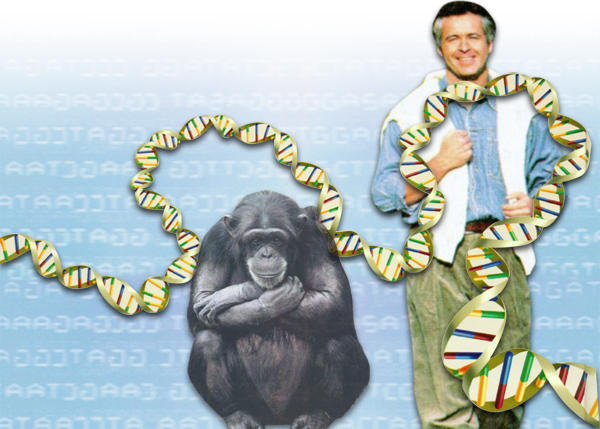
What is the significance of the fact that human DNA bears a 95% resemblance to that of chimpanzees? To answer this question, we need to look at some comparisons between human beings and other living things.
One of these comparisons provided the interesting result that there was a 75% similarity between man and worms of the nematode phylum.18 On the other hand, analyses based on certain proteins have portrayed man as close to very different creatures. In one study carried out by researchers at Cambridge University, certain proteins in some vertebrates were compared. Astonishingly, man and the chicken were paired off as closest relatives in nearly all cases. The next closest relative is the crocodile.19
The picture revealed by these studies is this: there are genetic similarities between man and other living things. Yet, these similarities do not reveal any kind of "evolutionary scheme."


Richard Owen
The existence of these genetic similarities is very normal, even inevitable. That is because the human body is made of the same materials, the same elements, as those of other living things. Man breathes the same air, eats the same food, and lives in the same climate as animals. All life on Earth is "carbon-based"; in other words, it is constructed from organic molecules (carbon compounds). Therefore, a human being naturally has proteins and genetic codes that are similar to those of other living things. This, however, does not mean that man and other organisms share a common origin or that man evolved from other creatures.
In fact, genetic comparisons among living things have struck at the very heart of the 150-year-old evolutionary tree. What, in that case, could be the scientific explanation of the similar structures in living things? The answer to that question was given before Darwin's theory of evolution came to dominate the world of science. Scientists like Carl Linnaeus, who first systematized living things according to their similar structures, and Richard Owen regarded these structures as examples of "common design." According to this idea, similar organs (or, nowadays, similar genes) are held to be so because they were intelligently designed to serve a particular purpose, not because they evolved by chance from a common ancestor.
Modern scientific findings show that the claim of a "common ancestor" made with regard to similar organs is incorrect, and that the only possible explanation is common design. In other words, living things were created according to a common plan.
The NAS goes on to suggest that a claim, which is a matter of dispute even among evolutionists, is established fact—namely, that the first human beings emerged in Africa and spread from there to the rest of the world. Yet, there is absolutely no evidence to support this claim. In an article published in Nature in 2002, Tim White dealt with the impossibility of such an assumption, stating:
Uncertainties surrounding the taxon's appearance in Eurasia and southeast Asia make it impossible to establish accurately the time or place of origin for H. erectus. Available evidence is insufficient to detect the direction of its geographic dispersal. 20

Discussions of the migration routes of man's ancestors—which is one of those topics that are the subject of much speculation despite a lack of evidence—led to the emergence of two main views in the 1980s. One of these, which the NAS maintains, is the hypothesis that the first human beings emerged in Africa from a single source and spread from there to the rest of the world. According to the other view, the first human beings emerged simultaneously in various regions of the world. Some of these people then encountered each other on their migratory routes, which led to the emergence of a new species by intermixing.
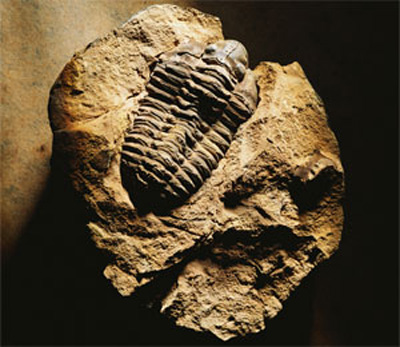
Since both of these hypotheses are based not on evidence, but on evolutionist scientists' preconceptions, it is not surprising that no consensus has emerged. Both hypotheses are riddled with contradictions and problems. Scientific American devoted some space to this problem in its August 1999 issue, noting that ". . . the significance of each finding has been questioned," referring to the methods on which these hypotheses are based.21
In conclusion, all we have are hypotheses, assumptions, and scenarios based on a very very sparse and controversial fossil record. The theory of evolution is unable to answer such fundamental questions as how life emerged on Earth or how different groups of living things came into being. It is at a total loss in the face of the different species that appear suddenly in the fossil record, as it is when confronted with the complex designs in living things. The proponents of evolution, therefore, speak not of basic and concrete facts, but rather of invented and mutually contradictory evolutionary scenarios. In this way, they attempt to conceal the fact that there is absolutely no scientific evidence to support the theory of evolution, which has now come to the end of its road.
In its chapter on human evolution, the NAS claims that DNA extracted from a well-preserved skeleton of Neanderthal Man was used to establish, by means of the molecular clock technique, that Neanderthal Man diverged from Homo sapiens half a million years ago. This species later became extinct. In the following paragraph, the NAS suggests that modern man evolved from more archaic humans some 100,000 to 150,000 years ago (Science and Creationism, p. 24). The classic evolutionist implication here is that Neanderthal Man became extinct before fully evolving into modern man, and that modern man is a totally different species. However, present-day findings show that Neanderthal Man lived together with Homo sapiens, and that the Neanderthals are an extinct human race, not a species different from man. You can find more details on this subject in our book Darwinism Refuted. The matter to be considered here is whether the data obtained from Neanderthal DNA are reliable.
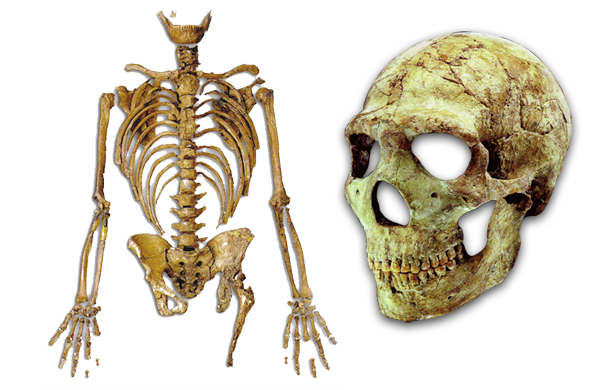
Top right is the Homo sapiens neanderthalensis skull Amud I, found in Israel. Neanderthal man is generally considered to have been short. However, this fossil specimen is estimated to have been around 1.80 m tall. Its brain volume is the largest so far encountered: 1740 cc. This fossil, therefore, demolishes the claims that Neanderthals were a primitive species. The Kebara 2 (Moshe) fossil to the right is the best complete Neanderthal specimen so far discovered. The skeletal structure of this 1.70-m tall individual is indistinguishable from that of modern man.
The DNA analysis in question was carried out by Svante Pääbo of Munich University. Pääbo and his team studied mitochondrial (mtDNA) obtained from Neanderthal fossils instead of nuclear DNA. The reason for the use of mtDNA in studies of this kind is that while there are only two copies of DNA in each cell nucleus, there are between 500 and 1,000 copies of mtDNA in each cell. There is thus a greater possibility of ancient mtDNA's having been preserved. However, there are serious difficulties that reduce the reliability of this DNA analysis. Some of these difficulties are as follows:
Here is one erroneous interpretation in the conclusions from this research: mtDNA obtained from Neanderthal Man was compared with mtDNA sequences from modern human beings, and the difference between the Neanderthal and modern human mtDNA sequences was determined to be greater than that between the mtDNAs of present-day humans. The method employed here is erroneous, however. A single sequence taken from the mtDNA of a single Neanderthal was compared to 994 sequences taken from 1,669 different modern humans. Bearing in mind that among these 1,669 people, some displayed differences among themselves as great as the difference between modern mtDNA and that of the Neanderthals, we can understand that the statistical results obtained are not trustworthy.22 For present-day human beings, an average was used, but no average could be obtained for Neanderthal Man, since the mtDNA sequence of only one individual was examined.
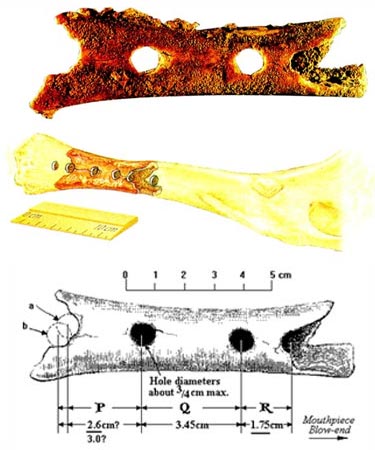 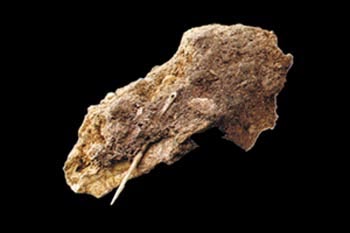 | THE NEANDERTHAL FLUTE A bone flute belonging to Neanderthal man. Calculations regarding this flute have shown that the holes were made in such a way as to produce correct notes; in other words, it is an expertly designed musical instrument. THE NEANDERTHAL NEEDLE An interesting fossil showing that Neanderthal man possessed knowledge of clothing tens of thousands of years before our own time: a 26,000-year-old needle. |

As has been discussed in earlier chapters, the evolutionary inferences based on the concept of the molecular clock do not reflect reality. And yet, the unconditional acceptance by evolutionists of the "molecular clock" concept lies at the root of the assumption that modern man and the Neanderthals were separate species. G.A. Clark of the University of Arizona has this to say about the unreliability of the "molecular clock" method:
Molecular clock models are full of problematic assumptions. Leaving aside differences of opinion about the rate of base pair substitutions, how to calibrate a molecular clock, and whether or not mtDNA mutations are neutral, the fact that the Neandertal sequence… differs from those of modern humans does not resolve the question of whether or not "moderns" and "Neandertals" were different species. 23
Karl J. Niklas of Cornell University refers to the use of the concept of the molecular clock to establish relationships between species as "…A research area that is at present characterized by too much speculation chasing too few data." 24
An article published in Science in 1998 said that the molecular clock could be in error by as much as twenty-fold. Neil Howard of the University of Texas Medical Branch says,
We've been treating this like a stop-watch, and I'm concerned that it's as precise as a sun dial. 25
Even evolutionists debate amongst themselves whether the use of mtDNA to determine evolutionary relationships is an accurate method. The Stanford University geneticist Luca Cavalli-Sforza and his associates write:
[T]he mitochondrial genome represents only a small fraction of an individual's genetic material and may not be representative of the whole.26
After testing the assumptions underlying the use of mtDNA to determine primate relationships, D. Melnick and G. Hoelzer of Columbia University provide the following information:
Our results suggest serious problems with use of mtDNA to estimate "true" population genetic structure, to date cladogenic [branching evolution] events, and in some cases, to construct phylogenies.27
The most important of these problems is the way these evolutionist scientists are blindly devoted to the theory of evolution. For this reason, research on the subject of evolution is not carried out objectively, and there is an attempt to make the data fit the theory of evolution. Kenneth A.R. Kennedy of Cornell University makes this comment:
This practice of forcing the paleontological and archaeological data to conform to the evolutionary and genetic models continues in reinterpretations of dates based upon the molecular clock of mitochondrial DNA as well as radiometric samples… 28
Pääbo's study on Neanderthal mtDNA is a typical example of this. According to the Cambridge University anthropologist Robert Foley, Pääbo and his team's study "shows plainly the futility of trying to interpret genes without knowing so much more—about selection and drift, about processes of cultural transmission, about history and geography, about fossils, about anthropology, about statistics." 29

No matter how loudly the NAS claims, in order to convince its readership, that there is no serious scientific doubt about human evolution, this is far from the case. The so-called evolution of man is one of the greatest dilemmas facing the theory of evolution. An article in Discovering Archeology magazine, one of the best-known publications concerned with the origin of man, written by its editor Robert Locke, says, "The search for human ancestors gives more heat than light," while the well-known paleoanthropologist Tim White makes this confession:
We're all frustrated by all the questions we haven't been able to answer.30
In the article, the dilemma facing the theory of evolution with regard to the origin of man and the groundlessness of the propaganda campaign waged to support it are described in this way:
Perhaps no area of science is more contentious than the search for human origins. Elite palaeontologists disagree over even the most basic outlines of the human family tree. New branches grow amid great fanfare, only to wither and die in the face of new fossil finds.31
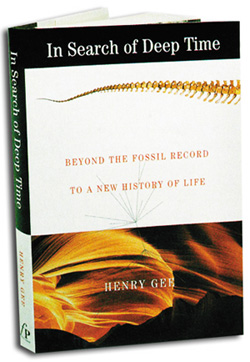
This same truth was recently accepted by Henry Gee, editor of the prestigious journal Nature. In his book In Search of Deep Time, published in 1999, Gee pointed out that all the evidence for human evolution "between about 10 and 5 million years ago—several thousand generations of living creatures—can be fitted into a small box." He concludes that conventional theories of the origin and development of human beings are "a completely human invention created after the fact, shaped to accord with human prejudices," and adds:
To take a line of fossils and claim that they represent a lineage is not a scientific hypothesis that can be tested, but an assertion that carries the same validity as a bedtime story—amusing, perhaps even instructive, but not scientific.32
Daniel E. Lieberman, of the George Washington University Anthropology Department, made the following comment in a statement issued regarding the fossil Kenyanthropus platyops, found in 2001:
The evolutionary history of humans is complex and unresolved. It now looks set to be thrown into further confusion by the discovery of another species and genus, dated to 3.5 million years ago… The nature of Kenyanthropus platyops raises all kinds of questions, about human evolution in general and the behavior of this species in particular… I suspect the chief role of K. platyops in the next few years will be to act as a sort of party spoiler, highlighting the confusion that confronts research into evolutionary relationships among hominins.33
The evolutionist paleontologists C. A. Villee, E. P. Solomon, and P. W. Davis admit that man emerged suddenly on Earth—in other words with no evolutionary ancestor before him—by saying, "We appear suddenly in the fossil record."34
In an article written in 2000, Mark Collard and Bernard Wood, two evolutionist anthropologists, were forced to state that "existing phylogenetic hypotheses about human evolution are unlikely to be reliable."35
Following are the views of some other evolutionists on this subject:
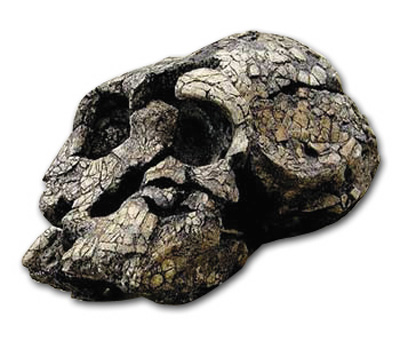
The fossil known as Kenyanthropus platyops, found in 2001, further invalidates the evolutionists' claims regarding the socalled evolution of man.
It is true that the data are fraught with numerous problems, . . . Many fossils are fragmentary, and the bones are sometimes difficult to restore to their original condition. An added problem is that the dating of human fossils [is] often complex and ambiguous. Finally, there are serious gaps in the fossil record.36
Compared to other sciences, the mythic element is greatest in paleoanthropology. Hypotheses and stories of human evolution frequently arise unprompted by data and contain a large measure of general preconceptions, and the data which do exist are often insufficient to falsify or even substantiate them. Many interpretations are possible. 37
Niles Eldredge and Ian Tattersall:
So the pattern emerges. We do not see constant progressive brain enlargement through time, or a climb to a more completely human posture. We see instead new "ideas," like upright posture, developed fully from the outset. We see the persistence, through millions of years, of species which continue on unchanged…38
Within the past few years five different trees have been offered for the branching order among hominids, chimps, gorillas, orangutans, and gibbons.39
[T]he account of our own origins on earth remains largely unknown.40
With respect to human origins, the discoveries made during the past fifteen years present a complex picture. The facts do not support the hypothesis of a simple progression Ramapithecus—Australopithecus—Homo habilis— H. erectus—H. sapiens. 41
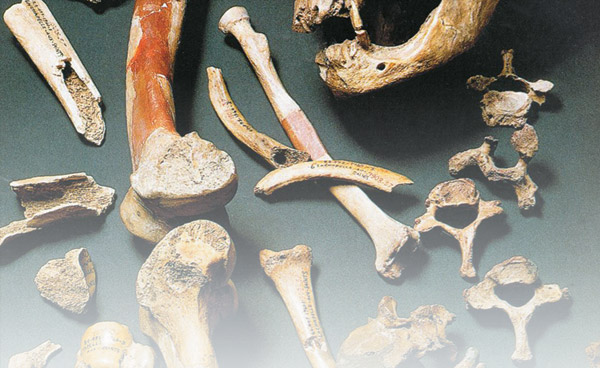
As we have seen, even evolutionists accept that so-called human evolution is not supported by the scientific findings. As has been shown throughout this book, the theory of evolution is not supported with facts but with totally ideological preconceptions. The theory of evolution—which is unable to explain how even a single cell came into being by random mechanisms, how man acquired the consciousness that makes him human (that is, the features of the human soul), or how lifeless and unconscious matter could turn into a thinking, speaking, rejoicing, and doubting human being, capable of feeling excitement and making discoveries—is one of the most irrational and unscientific claims ever made.

Discoveries regarding the origin of humans produce results conflicting with the theory of evolution. For instance, five different family trees have been suggested for the relationship among chimpanzees, gorillas, orangutans, and gibbons.
1. P. Andrews, Nature, 360 (6405): 641-6, 1992.
2. Richard C. Lewontin, Human Diversity, Scientific American Library: New York NY, 1995, p. 163. 
3. Henry Gee, "Palaeontology: Return to the planet of the apes," Nature, July 12, 2001.
4. B. Wood, "Origin and evolution of the genus Homo," Nature, 355 (6363): 783-90, 1992; http://www.icr.org/pubs/btg-a/btg-105a.htm
5. Michael D. Lemonick, "How Man Began," Time, March 14, 1994.
6. Richard Allan & Tracey Greenwood, Primates and Human Evolution in the textbook: Year 13 Biology 1999. Student Resource and Activity Manual, Biozone International. Printed in New Zealand, p. 260. (emphasis added)
7. Solly Zuckerman, Beyond The Ivory Tower, New York: Toplinger Publications, 1970, pp. 75-94.
8. Charles E. Oxnard, "The Place of Australopithecines in Human Evolution: Grounds for Doubt", Nature, vol. 258, p. 389.
9. E. Stokstad, "Hominid ancestors may have knuckle walked," Science 287(5461):2131, 2000.
10. Time, Lemonick and Dorfman, p. 61. (emphasis added)
11. Isabelle Bourdial, "Adieu Lucy," Science et Vie, May 1999, no. 980, pp. 52-62. 
12. Bjorn Kurten, Not From the Apes: A history of Man's Origins and Evolution, Columbia University Press, p. 12 
13. "A Genetic Perspective on the Origin and History of Humans," Dr. Takahata, writing in the Annual Review of Ecology and Systematics, 1995.
14. "How reliable are human phylogenetic hypotheses?,"PNAS, 25 April 2001, p. 5003.
15. Henry Gee, "Palaeontology: Return to the planet of the apes," Nature, July 12, 2001
16. http://www.cnn.com/2002/TECH/science/09/24/humans.chimps.ap/index.html
17. "Human-chimp DNA difference trebled," New Scientist, September 23,2002; http://www.newscientist.com/news/news.jsp?id=ns99992833
18. New Scientist, May 15, 1999, p. 27.
19. New Scientist, vol. 103, August 16, 1984, p. 19.
20. Tim White et al, "Remains of Homo erectus from Bouri-Middle Awash-Ethiopia," Nature 416, March 21, 2002, pp. 317-320.
21. Kate Wong, "Is Out of Africa Going Outdoor?," Scientific American, August 1999.
22. Marvin Lubenow, "Recovery of Neandertal mtDNA: An Evaluation," http://www.answersingenesis.org/docs/4218tj_v12n1.asp
23. RS Corruccini, 1992. Metrical reconsideration of the Skhul IV and IX and Border Cave 1 crania in the context of modern human origins, American Journal of Physical Anthropology, 87(4):440-442.
24. K.J. Niklas, 1990. Turning over an old leaf. Nature, 344:587.
25. A. Gibbons, 1998. Calibrating the mitochondrial clock. Science, 279 (2 January 1998), p. 28.
26. J.L. Mountain, A.A. Lin, A.M. Bowcock, and L.L. Cavalli-Sforza, 1993. M.J. Aitken, C.B. Stringer, and P.A. Mellars (eds), Evolution of modern humans: evidence from nuclear DNA polymorphisms. The Origin of Modern Humans and the Impact of Chronometric Dating, Princeton: Princeton University Press, p. 69.
27. D. Melnick and G. Hoelzer, 1992. What in the study of primate evolution is mtDNA good for? American Journal of Physical Anthropology, Supplement 14, p. 122.
28. K.A.R. Kennedy, 1992. Continuity of replacement: controversies in Homo Sapiens evolution, American Journal of Physical Anthropology, 89(2):271, 272.
29. R. Foley, "Talking genes," Nature, 377, October 12, 1995, pp. 493–494.
30. Robert Locke, "Family Fights" Discovering Archaeology, July/August 1999, pp. 36-39.
31. Robert Locke, "Family Fights" Discovering Archaeology, July/August 1999, p. 36.
32. Henry Gee, In Search of Deep Time, New York: The Free Press, 1999, pp. 32, 116, 117, 202.
33. Daniel E. Lieberman, "Another face in our family tree", Nature, March 22, 2001.
34. Frank Sherwin, "Was Darwin Vindicated?" Institute for Creation Research; http://www.icr.org/headlines/darwinvindicated.html (emphasis added) 
35. "Hominoid Evolution and Climatic Change in Europe" vol. 2 Edited by Louis de Bonis, George D. Koufos, Peter Andrews, Cambridge University Press 2001, Chapter 6.
36. J. Bower, "The Evolution and Origin of Humankind," in Wilson, D.B., 1983, p. 123.
37. A. Hill, Book Review, American Scientist, vol. 72, 1984, p.189.
38. N. Eldredge ve I. Tattersall, The Myths of Human Evolution, Columbia University Press, 1982, p.8.
39. D. Willis, The Hominid Gang: Behind the Scenes in the Search for Human Origins, Viking Press, 1989, p. 284. 
40. D. Willis, The Hominid Gang: Behind the Scenes in the Search for Human Origins, Viking Press, 1989, p. 34. 
41. G.L. Stebbins, Darwin to DNA, Molecules to Humanity, W.H. Freeman and Company, 1982, p. 352. 